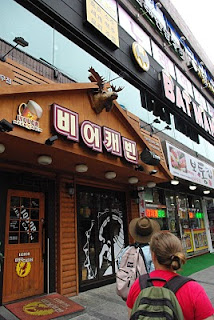
Last Saturday we headed in to Suwon to visit the Korean Folk Village. I would highly recommend making the trip in to Suwon if you’re ever visiting Seoul or other nearby cities in Korea. The village is a reconstruction of many different styles and types of Korean buildings – scholar’s homes, temples, palaces, governor’s mansions, or the farmer’s thatched roof cottage (THATCHED ROOF COTTAGES!) shown here. There are so many interactive elements to the whole place - you can learn to make paper, straw sandals, and pottery, or you can try your hand at farm machinery, try catching a mudloach, wear traditional clothes, sit in a palanquin, and tons of other little activities. The three of us learned a lot about traditional Korean culture, AND had a lot of fun – true edutainment. The whole place is a little bit like Fortress Louisbourg in Cape Breton, or Fort Edmonton Park.

Robin and I wrote wishes on little pieces of paper and tied them to the strings on this rock pile. I wished for good specimens during my Gobi fieldwork in August. Robin wished for something lame like health and happiness for her family...

There appeared to be a working Buddhist temple set a little ways off the main paths. Up many sets of stairs and gardens was a beautiful building with this gold Buddha and fruit offerings.

One of my favourite things we saw on Saturday was a traditional farmer’s drum and dance performance. Several of the men were wearing these amazing streamer hats. The sticks on the back of the hats can swing around freely in a circle, and attached to the end is a streamer. By flicking their heads in different directions, the dancers could produce amazing streamer patterns that were completely amazing to watch.



















































